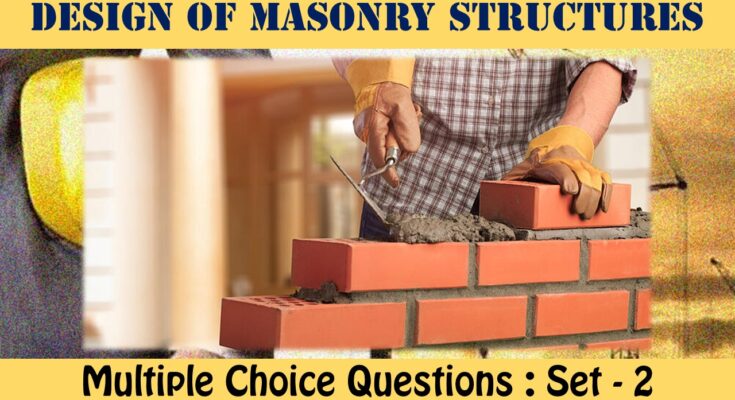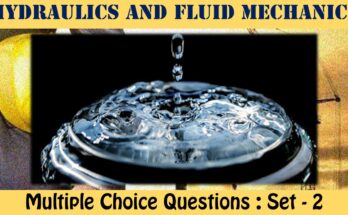MCQ Questions Civil Engineering Design of Masonry Structures
The interviewer is almost as nervous as the candidate in most interviews. You might wonder if you look confident enough, if you will hire the right person, or if you are asking the right engineering interview questions. The last question is arguably the most crucial part to worry about when you’re interviewing candidates. Other topics on Civil Engineering Multiple Choice Questions can be accessed
MCQ Questions Civil Engineering Design of Masonry Structures - Set - 2
Question 1:
Water retentivity for brick masonry should not be less than
a) 50%
b) 60%
c) 70%
d) 80%
Correct Answer – (C)
Question 2 :
Assertion A : Lime based mortars give higher ratio of brickwork strength to mortar strength as compared to non-lime mortar.
Reason R : Lime based mortars have lower bond strength as compared to non-lime mortars.
Select your answer according to the codes given below:
a) Both A and R are true and R is the correct explanation of A.
b) Both A and R are true but R is not the correct explanation of A.
c) A is true but R is false.
d) A is false but R is true.
Correct Answer – (C)
Question 3 :
Full restraint is provided by
(i) foundation footing of a wall
(ii) timber floor spanning on the wall and anchored to the wall
(iii) RCC slab with a minimum bearing of 10 cm on the wall Of these statements
a) (i) and (iii) are correct
b) (i) and (ii) are correct
c) (ii) and (iii) are correct
d) (i), (ii) and (iii) are correct
Correct Answer – (D)
Question 4 :
Assertion A : From consideration of structural soundness and economy of design, most codes control the maximum slenderness ratio of masonry walls and columns.
Reason R : By controlling the maximum slenderness ratio, failure is by excessive stress and not by buckling. Select your answer according to codes given below:
a) Both A and R are true and R is the correct explanation of A.
b) Both A and R are true but R is not .the correct explanation of A.
c) A is true but R is false.
d) A is false but R is true.
Correct Answer – (A)
Question 5 :
For designing masonry components of a structure, seismic forces provision in the design calculation is not necessary for buildings constructed in
a) Zone I only
b) Zone I and II
c) Zone I, II and III
d) Zone I, II, III and IV
Correct Answer – (B)
MCQ Questions Civil Engineering Design of Masonry Structures
Question 6:
For masonry work with solid bricks, consistency of mortar should be
a) 5 to 8 cm
b) 9 to 13 cm
c) 14 to 18 cm
d) 19 to 23 cm
Correct Answer – (B)
Question 7:
Minimum thickness of stiffening wall for 1 to 3 storeys shall not be less than
a) 10 cm
b) 15 cm
c) 20 cm
d) 30 cm
Correct Answer – (A)
Question 8:
The timber floor not spanning on the masonry wall but properly anchored to the wall gives
a) lateral restraint but not rotational restraint
b) rotational restraint but not lateral restraint
c) both lateral and rotational restraints
d) neither lateral nor rotational restraint
Correct Answer – (A)
Question 9:
The mode of failure of a very short masonry member having h/t ratio of less than 4 is by
a) shear
b) vertical tensile splitting
c) buckling
d) any of the above
Correct Answer – (A)
Question 10:
If the eccentricity ratio is more than 1/24, then increase in the permissible stress in the design of wall subjected to eccentric loading as per code is
a) 10%
b) 25%
c) 33(1/3)%
d) 50%
Correct Answer – (B)
- NCERT Solutions Class 12 Mathematics RD Sharma Sets : Exercise 1.1
- NCERT Solutions Class 12 Mathematics RD Sharma Sets : Exercise 1.2
- NCERT Solutions Class 12 Mathematics RD Sharma Sets : Exercise 1.3
- NCERT Solutions Class 12 Mathematics RD Sharma Sets : Exercise 1.4
- NCERT Solutions Class 12 Mathematics RD Sharma Trigonometric Functions : Exercise – 5.1
- NCERT Solutions Class 12 Mathematics RD Sharma Trigonometric Functions : Exercise – 5.2
- NCERT Solutions Class 12 Mathematics RD Sharma Trigonometric Functions : Exercise – 5.3
- NCERT Solutions Class 12 Mathematics RD Sharma Quadratic Equations : Exercise – 14.1
- NCERT Solutions Class 12 Mathematics RD Sharma Quadratic Equations : Exercise – 14.2
- NCERT Solutions Class 12 Mathematics RD Sharma Linear Inequations : Exercise – 15.1
- NCERT Solutions Class 12 Mathematics RD Sharma Linear Inequations : Exercise – 15.2
- NCERT Solutions Class 12 Mathematics RD Sharma Linear Inequations : Exercise – 15.3
- NCERT Solutions Class 12 Mathematics RD Sharma Linear Inequations : Exercise – 15.4
- NCERT Solutions Class 12 Mathematics RD Sharma Linear Inequations : Exercise – 15.5
- NCERT Solutions Class 12 Mathematics RD Sharma Linear Inequations : Exercise – 15.6
Multiple Choice Questions for Competitive Exams
- Multiple Choice Questions Class 12 Chemistry The Solid State
Set -1 Set -2 Set -3 Set -4 Set -5 - MCQ Questions Class 12 Solutions With Answers
Set -1 Set -2 Set -3 Set -4 Set -5 - MCQ Questions Class 12 Electrochemistry With Answers
Set -1 Set -2 Set -3 Set -4 Set -5 - MCQ Questions Class 12 Chemical Kinetics With Answers
Set -1 Set -2 Set -3 Set -4 Set -5 - MCQ Questions Class 12 Surface Chemistry With Answers
Set -1 Set -2 Set -3 Set -4 Set -5 - MCQ Questions Class 12 General Principles and Processes of Isolation of Elements With Answers
Set -1 Set -2 Set -3 Set -4 Set -5




